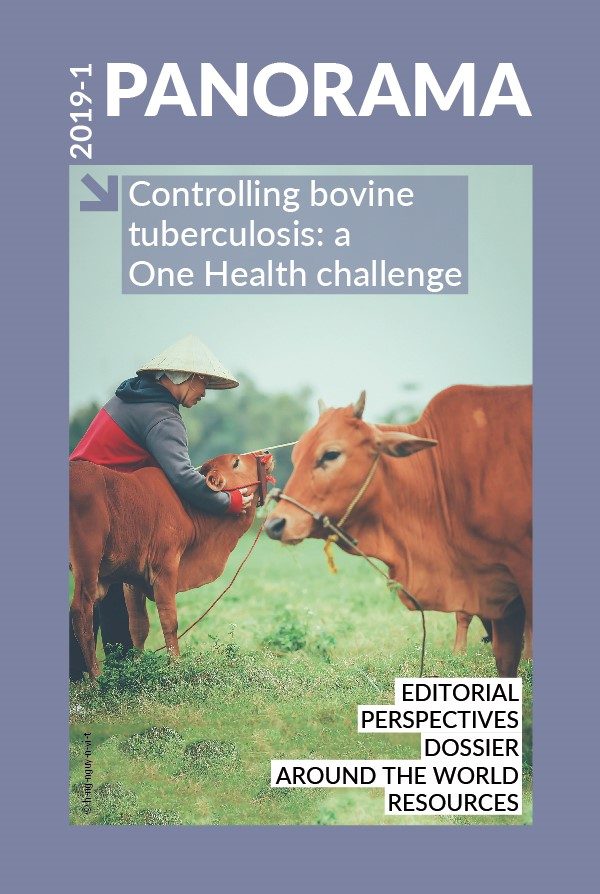Dossier Posted on 2019-04-29 18:47:17
BCG-compatible DIVA skin tests for cattle vaccinated against bovine tuberculosis
Keywords
Authors
H.M. Vordermeier(1,2)*, G. Jones(2), V. Kapur(3) & R.G. Hewinson(1)
(1) Institute for Biological, Environmental and Rural Sciences, Aberystwyth University, United Kingdom.
(2) Animal and Plant Health Agency, Department of Bacteriology, Addlestone, United Kingdom.
(3) The Pennsylvania State University, Department of Animal Sciences, and The Huck Institutes, University Park, Pennsylvania, United States of America.
* Corresponding author: martin.vordermeier@apha.gov.uk
The designations and denominations employed and the presentation of the material in this article do not imply the expression of any opinion whatsoever on the part of the OIE concerning the legal status of any country, territory, city or area or of its authorities, or concerning the delimitation of its frontiers and boundaries.
The views expressed in this article are solely the responsibility of the author(s). The mention of specific companies or products of manufacturers, whether or not these have been patented, does not imply that these have been endorsed or recommended by the OIE in preference to others of a similar nature that are not mentioned.
Cattle vaccination could be added to existing control strategies, but the only cattle vaccine candidate available, BCG, does not protect all vaccinated animals and compromises the utility of tuberculin purified protein derivative (PPD) in diagnostic tests. To apply BCG alongside PPD-based test-and-cull approaches, e.g. based on the single intradermal comparative cervical tuberculin test (SICCT), requires replacing or supplementing PPD with BCG-compatible tests to detect infected animals within vaccinated populations.
The discovery that a number of gene regions were deleted from the BCG genome during its attenuation allowed a rational search for DIVA antigens based on antigens encoded by these ‘regions of difference’. Two such antigens, ESAT-6 and CFP-10, were shown to fulfil the DIVA criteria [1]. However, although these two DIVA antigens were highly specific in cattle, their sensitivity was inferior to that of PPD. Subsequently, an ‘omics’-based antigen mining programme identified the antigen Rv3615c, which when used to complement ESAT-6 and CFP-10 provided significant additional sensitivity without reducing specificity [2]. However, matching DIVA specificity in BCG-vaccinated animals to SICCT specificity in unvaccinated cattle using the blood test format resulted in loss of sensitivity. We correctly hypothesised that the required high specificity could be achieved by using a cocktail of the three antigens as skin test antigens [3]. This cocktail displayed comparable sensitivity to the SICCT, while its specificity in BCG-vaccinated animals matched that of the SICCT in unvaccinated cattle [4].
Further product development led to the generation of a fusion protein composed of all three antigens [5] which exhibited performance equal to that of the protein cocktail, but with a better production and stability profile. A parallel development led to a peptide cocktail representing the same proteins. The next stage in the development of these potentially groundbreaking DIVA reagents is to validate them to OIE standards [6].
http://dx.doi.org/10.20506/bull.2019.1.2964
References
- Vordermeier H.M., Jones G.J., Buddle B.M., Hewinson R.G. & Villarreal-Ramos B. (2016). – Bovine tuberculosis in cattle: vaccines, DIVA tests, and host biomarker discovery. Annu. Rev. Anim. Biosci., 4, 87–109. https://doi.org/10.1146/annurev-animal-021815-111311.
- Sidders B., Pirson C., Hogarth P.J., Hewinson R.G., Stoker N.G., Vordermeier H.M. et al. (2008). – Screening of highly expressed mycobacterial genes identifies Rv3615c as a useful differential diagnostic antigen for the Mycobacterium tuberculosis complex. Infect. Immun., 76 (9), 3932–3939. https://doi.org/10.1128/IAI.00150-08.
- Whelan A.O., Clifford D., Upadhyay B., Breadon E.L., McNair J., Hewinson R.G. et al. (2010). – Development of a skin test for bovine tuberculosis for differentiating infected from vaccinated animals. J. Clin. Microbiol., 48 (9), 3176–3181. https://doi.org/10.1128/JCM.00420-10.
- Vordermeier H.M., Jones G.J., Buddle B.M. & Hewinson R.G. (2016). – Development of immuno-diagnostic reagents to diagnose bovine tuberculosis in cattle. Vet. Immunol. Immunopathol., 181, 10–14. https://doi.org/10.1016/j.vetimm.2016.02.003.
- Srinivasan S., Jones G.J., Veerasane M., Steinbach S., Holder T., Zewude A., Fromsa A., Ameni G., Easterling L., Bakker D., Juleff N., Gifford G., Hewinson R.G., Vordermeier H.M. & Kapur V. (2019). – A defined antigen skin test for the diagnosis of bovine tuberculosis. Science Advances. In press.
- World Organisation for Animal Health (OIE) (2018). – Chapter 3.4.6. Bovine tuberculosis. In Manual of Diagnostic Tests and Vaccines for Terrestrial Animals. 8th Edition.










